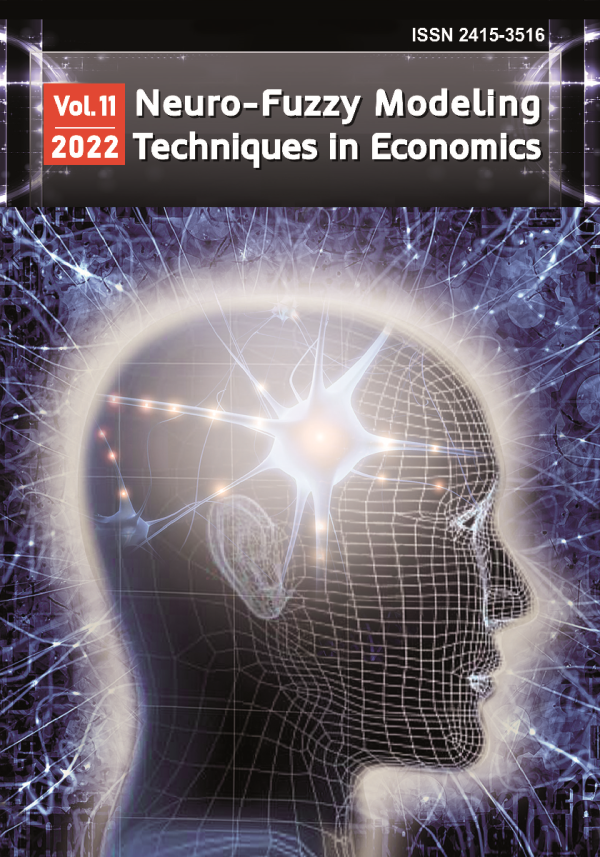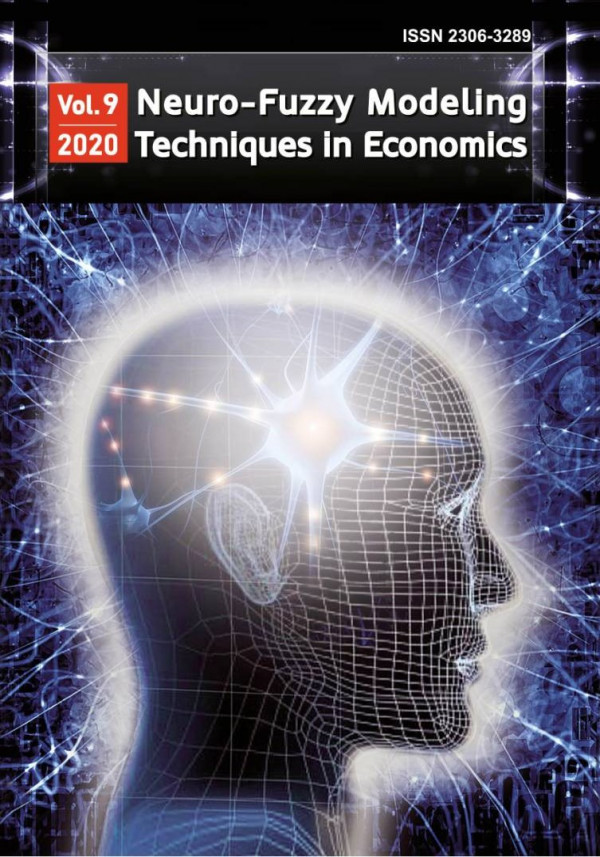
Neuro-Fuzzy Modeling Techniques in Economics
ISSN 2415-3516
Підхід на основі машинного навчання до аналізу емоційної полярності електронних соціальних медіа
Machine learning approach of analysis of emotional polarity of electronic social media
DOI:
10.33111/nfmte.2020.095
Анотація: У статті пропонується новий підхід до оцінки емоційної полярності (або аналізу настроїв) електронних текстів у соціальних мережах. Для цього використовувалися як класичні методи машинного навчання (логістична регресія та метод опорних векторів), так і інструментарій глибоких нейронних мереж (повнозв’язні та згорткові нейромережі). Векторне представлення ґрунтувалось на частотних та попередньо навчених вкладеннях слів Word2vec і GloVe (з розмірами вкладення 100 і 300).
Для вибраного англомовного набору даних IMDb Movie Reviews точність класифікації за допомогою моделі логістичної регресії становила 87%, машини опорних векторів – 87,5%, повнозв’язної нейронної мережі – 88% і згорткової мережі – 90%. Точність запропонованих моделей є цілком прийнятною для практичних ситуацій і не поступається передовим рішенням у сфері обробки природньої мови за напрямом аналізу настроїв, що відкриває обнадійливі перспективи для подальших досліджень
Abstract: This paper proposes a new approach to evaluating the emotional polarity (or Sentiment Analysis) of electronic social media texts. For this purpose both conventional Machine Learning (Logistic Regression and Support Vector Machine), and Deep Neural Networks approaches (Fully Connected and Convolutional Neural Networks) were used. As vector representations of words, we used both the frequency-based and pretrained words embeddings Word2vec and GloVe (with embedding dimensions of size 100 and 300).
For the selected English-language IMDb Movie Reviews dataset the classification accuracy using the Logistic Regression model was 87%, the Support Vector Machine – 87.5%, the Fully Connected Neural Network – 88%, and the Convolutional Network – 90%. The accuracy of the proposed models is a quite acceptable for practical use-cases and is not inferior to cutting-edge Natural Language Processing solutions in the field of Sentiment Analysis, which opens up good prospects for further research.
Ключові слова: виявлення емоційної полярності, аналіз настроїв, електронні соціальні медіа, машинне навчання, глибинне навчання
Key words: emotional polarity detection, sentiment analysis, electronic social media, machine learning, deep learning
УДК: 519.767.6
UDC: 519.767.6
JEL: C45 C53 C89
To cite paper
In APA style
Derbentsev, V., Bezkorovainyi, V., & Akhmedov, R. (2020). Machine learning approach of analysis of emotional polarity of electronic social media. Neuro-Fuzzy Modeling Techniques in Economics, 9, 95-137. http://doi.org/10.33111/nfmte.2020.095
In MON style
Дербенцев В., Безкоровайний В.С., Ахмедов Р. Підхід на основі машинного навчання до аналізу емоційної полярності електронних соціальних медіа. Нейро-нечіткі технології моделювання в економіці. 2020. № 9. С. 95-137. http://doi.org/10.33111/nfmte.2020.095 (дата звернення: 08.01.2026).
With transliteration
Derbentsev, V., Bezkorovainyi, V., Akhmedov, R. (2020) Pidkhid na osnovi mashynnoho navchannia do analizu emotsiinoi poliarnosti elektronnykh sotsialnykh media [Machine learning approach of analysis of emotional polarity of electronic social media]. Neuro-Fuzzy Modeling Techniques in Economics, no. 9. pp. 95-137. http://doi.org/10.33111/nfmte.2020.095 (accessed 08 Jan 2026).
 # 9 / 2020
# 9 / 2020
Download Paper

747
Views
157
Downloads
0
Cited by
- Kemp, S. (2020, January 30). Digital 2020: Global Digital Overview. DataReportal. https://datareportal.com/reports/digital-2020-global-digital-overview
- Li, H. (2017). Deep learning for natural language processing: advantages and challenges. National Science Review, 5(1), 24-26. https://doi.org/10.1093/nsr/nwx110
- Silberztein, M., Atigui, F., Kornyshova, E., Métais, E., & Meziane, F. (Eds.). (2018). Lecture Notes in Computer Science: Vol. 10859. Natural Language Processing and Information Systems. Springer. https://doi.org/10.1007/978-3-319-91947-8
- Soloviev, V., Moiseienko, N., & Tarasova, O. (2020). Complexity Theory and Dynamic Characteristics of Cognitive Processes. In V. Ermolayev, F. Mallet, V. Yakovyna, H. Mayr, & A. Spivakovsky (Eds.), Communications in Computer and Information Science: Vol. 1175. Information and Communication Technologies in Education, Research, and Industrial Applications (pp. 231–253). Springer. https://doi.org/10.1007/978-3-030-39459-2_11
- Kiv, A., Soloviev, V., Tarasova, E., Koycheva, T., & Kolesnykova, K. (2020). Semantic knowledge networks in education. E3S Web of Conferences, 166, Article 10022. https://doi.org/10.1051/e3sconf/202016610022
- Lane, H., Howard, C., & Hapke, H. (2019). Natural Language Processing in Action: Understanding, Analyzing, and Generating Text with Python. Manning Publications Co.
- Pozzi, F., Fersini, E., Messina, E., & Liu, B. (2017). Sentiment Analysis in Social Networks. Elsevier. https://doi.org/10.1016/B978-0-12-804412-4.09994-0
- Zhang, X., & Ghorbani, A. A. (2020). An overview of online fake news: Characterization, detection, and discussion. Information Processing & Management, 57(2), Article 102025. https://doi.org/10.1016/j.ipm.2019.03.004
- Shu, K., Sliva, A., Wang, S., Tang, J., & Liu, H. (2017). Fake news detection on social media: A data mining perspective. ACM SIGKDD explorations newsletter, 19(1), 22-36. https://doi.org/10.1145/3137597.3137600
- Kononova, K. (2017). Trust evaluation: theoretical models and results of empirical research on social networks. Neiro-Nechitki Tekhnolohii Modelyuvannya v Ekonomitsi (Neuro-Fuzzy Modeling Techniques in Economics), 6, 68-89. https://doi.org/10.33111/nfmte.2017.068 [In Russian]
- Iglesias, C., & Moreno, A. (Eds.). (2020). Sentiment Analysis for Social Media. MDPI. https://doi.org/10.3390/books978-3-03928-573-0
- Kononova, K., & Dek, A. (2018). Investigation of traders’ behavioral characteristics: experimental economics methods and machine learning technologies. Neiro-Nechitki Tekhnolohii Modelyuvannya v Ekonomitsi (Neuro-Fuzzy Modeling Techniques in Economics), 7, 148-167. https://doi.org/10.33111/nfmte.2018.148 [In Ukrainian]
- Khoo, C. S., & Johnkhan, S. B. (2018). Lexicon-based sentiment analysis: Comparative evaluation of six sentiment lexicons. Journal of Information Science, 44(4), 491-511. https://doi.org/10.1177/0165551517703514
- Karamollaoglu, H., Dogru, I. A., Dorterler, M., Utku, A., & Yıldız, O. (2018). Sentiment analysis on Turkish social media shares through lexicon based approach. In Proceedings of the 2018 3rd International Conference on Computer Science and Engineering (UBMK) (pp. 45-49). IEEE. https://doi.org/10.1109/UBMK.2018.8566481
- Dhaoui, C., Webster, C. M., & Tan, L. P. (2017). Social media sentiment analysis: Lexicon versus Machine Learning. Journal of Consumer Marketing, 34(6), 480-488. https://doi.org/10.1108/JCM-03-2017-2141
- Kumar, A., & Jaiswal, A. (2020). Systematic literature review of sentiment analysis on Twitter using soft computing techniques. Concurrency and Computation: Practice and Experience, 32(1), Article e5107. https://doi.org/10.1002/cpe.5107
- Drus, Z., & Khalid, H. (2019). Sentiment Analysis in Social Media and Its Application: Systematic Literature Review. Procedia Computer Science, 161, 707-714. https://doi.org/10.1016/j.procs.2019.11.174
- D’Andrea, A., Ferri, F., Grifoni, P., & Guzzo, T. (2015). Approaches, Tools and Applications for Sentiment Analysis Implementation. International Journal of Computer Applications, 125(3), 26-33. https://doi.org/10.5120/ijca2015905866
- Moussa, M., Mohamed, E., & Haggag, M. (2018). A survey on opinion summarization techniques for social media. Future Computing and Informatics Journal, 3(1), 82-109. https://doi.org/10.1016/j.fcij.2017.12.002
- Jain, P. K., & Pamula, R. (2020). A systematic literature review on machine learning applications for consumer sentiment analysis using online reviews. arXiv. https://doi.org/10.48550/arXiv.2008.10282
- Amrani, Y., Lazaar, M., & Kadiri, K. (2018). Random Forest and Support Vector Machine based Hybrid Approach to Sentiment Analysis. Procedia Computer Science, 127, 511-520. https://doi.org/10.1016/j.procs.2018.01.150
- Chen, N, & Wang, P. (2018). Advanced combined LSTM-CNN model for Twitter sentiment analysis. In Proceedings of the 2018 5th IEEE International Conference on Cloud Computing and Intelligence Systems (CCIS) (pp. 684-687). IEEE. https://doi.org/10.1109/CCIS.2018.8691381
- Sahu, T.P., & Ahuja, S. (2016). Sentiment analysis of movie reviews: A study on feature selection & classification algorithms. In Proceedings of the 2016 International Conference on Microelectronics, Computing and Communications (MicroCom) (pp. 1-6). IEEE. https://doi.org/10.1109/MICROCOM.2016.7522583
- Yenter, A., & Verma, A. (2017). Deep CNN-LSTM with combined kernels from multiple branches for IMDb review sentiment analysis. In Proceedings of the 2017 IEEE 8th Annual Ubiquitous Computing, Electronics and Mobile Communication Conference (UEMCON) (pp. 540-546). IEEE. https://doi.org/10.1109/UEMCON.2017.8249013
- Ali, N.M., Hamid, M.M., & Youssif, A. (2019). Sentiment Analysis For Movies Reviews Dataset Using Deep Learning Models. International Journal of Data Mining & Knowledge Management Process, 9(2/3), 19-27. https://doi.org/10.5121/ijdkp.2019.9302
- Haque, M. R., Lima, S. A., & Mishu, S. Z. (2019). Performance Analysis of Different Neural Networks for Sentiment Analysis on IMDb Movie Reviews. In Proceedings of the 2019 3rd International Conference on Electrical, Computer & Telecommunication Engineering (ICECTE) (pp. 161-164). IEEE. https://doi.org/10.1109/ICECTE48615.2019.9303573
- Quraishi, A. (2020). Performance Analysis of Machine Learning Algorithms for Movie Review. International Journal of Computer Applications, 177(36), 7-10. https://doi.org/10.5120/ijca2020919839
- Kamath, U., Liu, J., & Whitaker, J. (2019). Deep Learning for NLP and Speech Recognition. Springer Nature Switzerland AG. https://doi.org/10.1007/978-3-030-14596-5
- Mikolov, T., Chen, K., Corrado, G., & Dean, J. (2013). Efficient estimation of word representations in vector space. arXiv. https://doi.org/10.48550/arXiv.1301.3781
- Marginalia. (2018, January 6). The backpropagation algorithm for Word2Vec. http://www.claudiobellei.com/2018/01/06/backprop-word2vec/
- Pennington, J., Socher, R., & Manning, C. (2014). GloVe: Global vectors for word representation. In Proceedings of the 2014 Conference on Empirical Methods in Natural Language Processing (EMNLP) (pp. 1532-1543). Association for Computational Linguistics. https://doi.org/10.3115/v1/D14-1162
- Mohri, M., Rostamizadeh, A., Talwalkar, A. (2018). Foundations of Machine Learning (2nd ed.). MIT Press.
- LeCun, Y., & Bengio, Y. (1995). Convolutional networks for images, speech, and time-series. In M. A. Arbib (Ed.), The handbook of brain theory and neural networks (pp. 255-258). The MIT Press.
- Kim, Y. (2014). Convolutional neural networks for sentence classification. arXiv. https://doi.org/10.48550/arXiv.1408.5882
- Scikit-Learn. (n.d.). Machine Learning in Python. Retrieved January 25, 2020, from https://scikit-learn.org/stable/
- Keras. (n.d.). Keras: Simple. Flexible. Powerful. Retrieved January 25, 2020, from https://keras.io
- TensorFlow. (n.d.). Create production-grade machine learning models with TensorFlow. Retrieved January 25, 2020, from https://www.tensorflow.org
- IMDb. (n.d.). IMDb Datasets [Data set]. Retrieved January 9, 2020, from https://www.imdb.com/interfaces/
- NLTK. (n.d.). Natural Language ToolKit. Retrieved January 25, 2020, from https://www.nltk.org
- Gensim. (n.d.). Topic modelling for humans. Retrieved January 25, 2020, from https://radimrehurek.com/gensim/
- Noh, Y., Park, S., & Park, S.-B. (2019). Aspect-Based Sentiment Analysis Using Aspect Map. Applied Sciences, 9(16), Article 3239. https://doi.org/10.3390/app9163239
- Sarhan, I., & Spruit, M. (2020). Can We Survive without Labelled Data in NLP? Transfer Learning for Open Information Extraction. Applied Sciences, 10(17), Article 5758. https://doi.org/10.3390/app10175758

